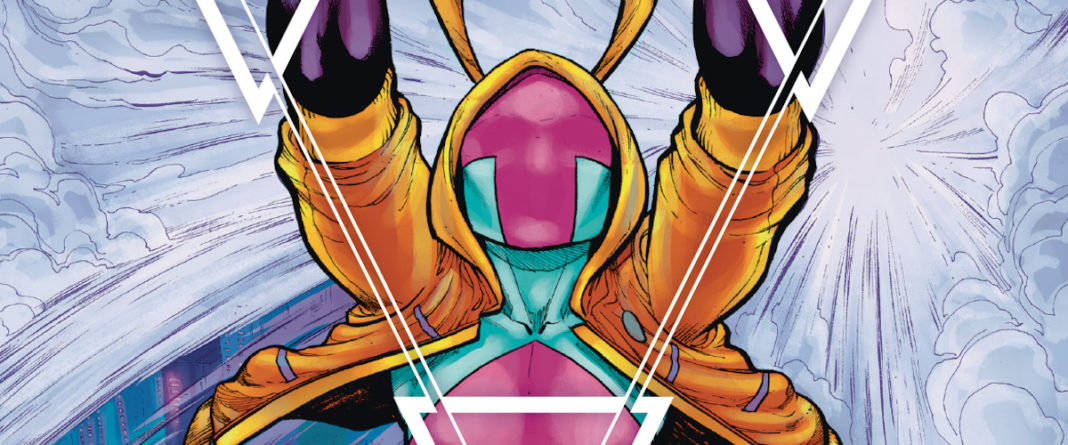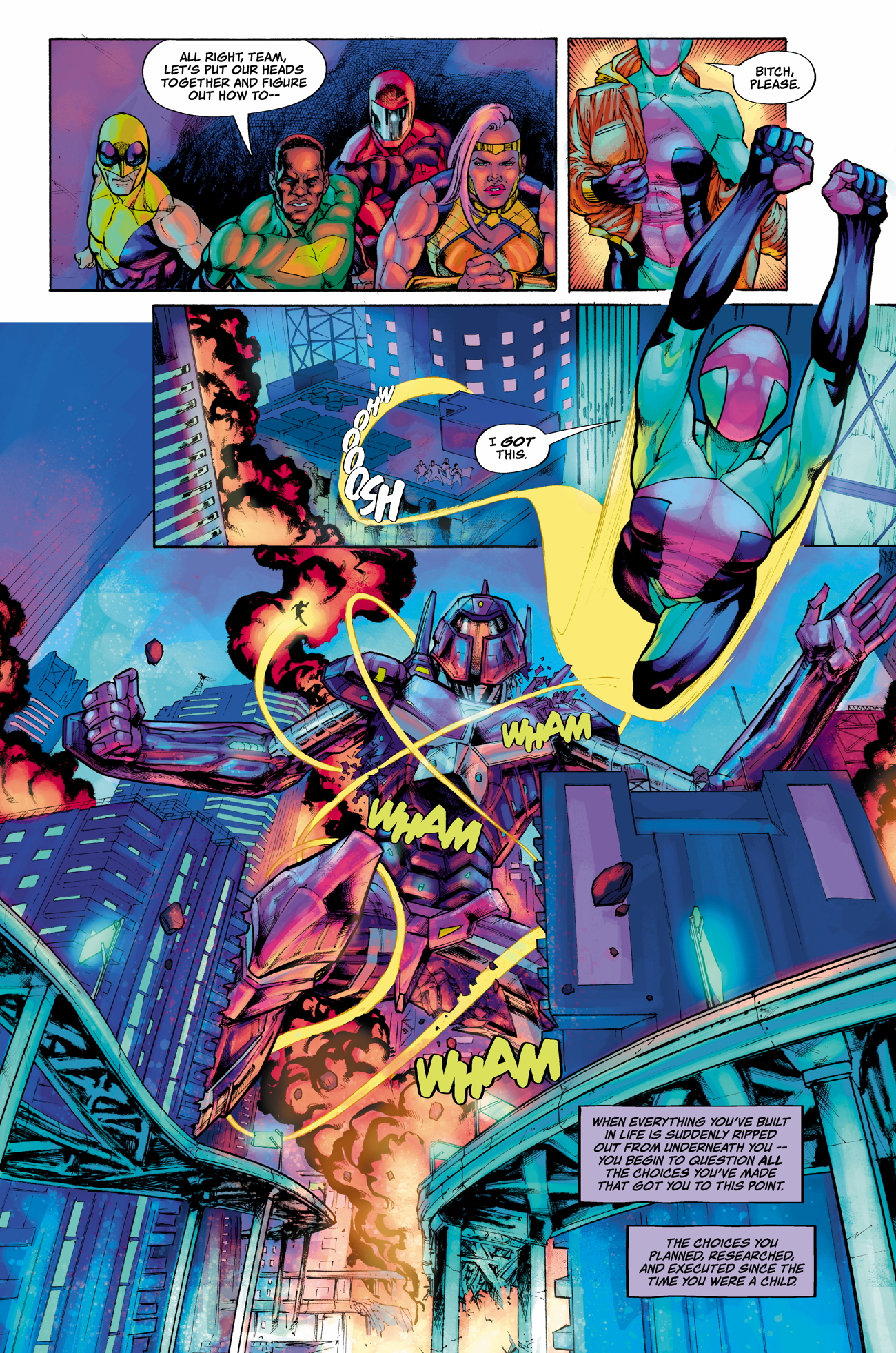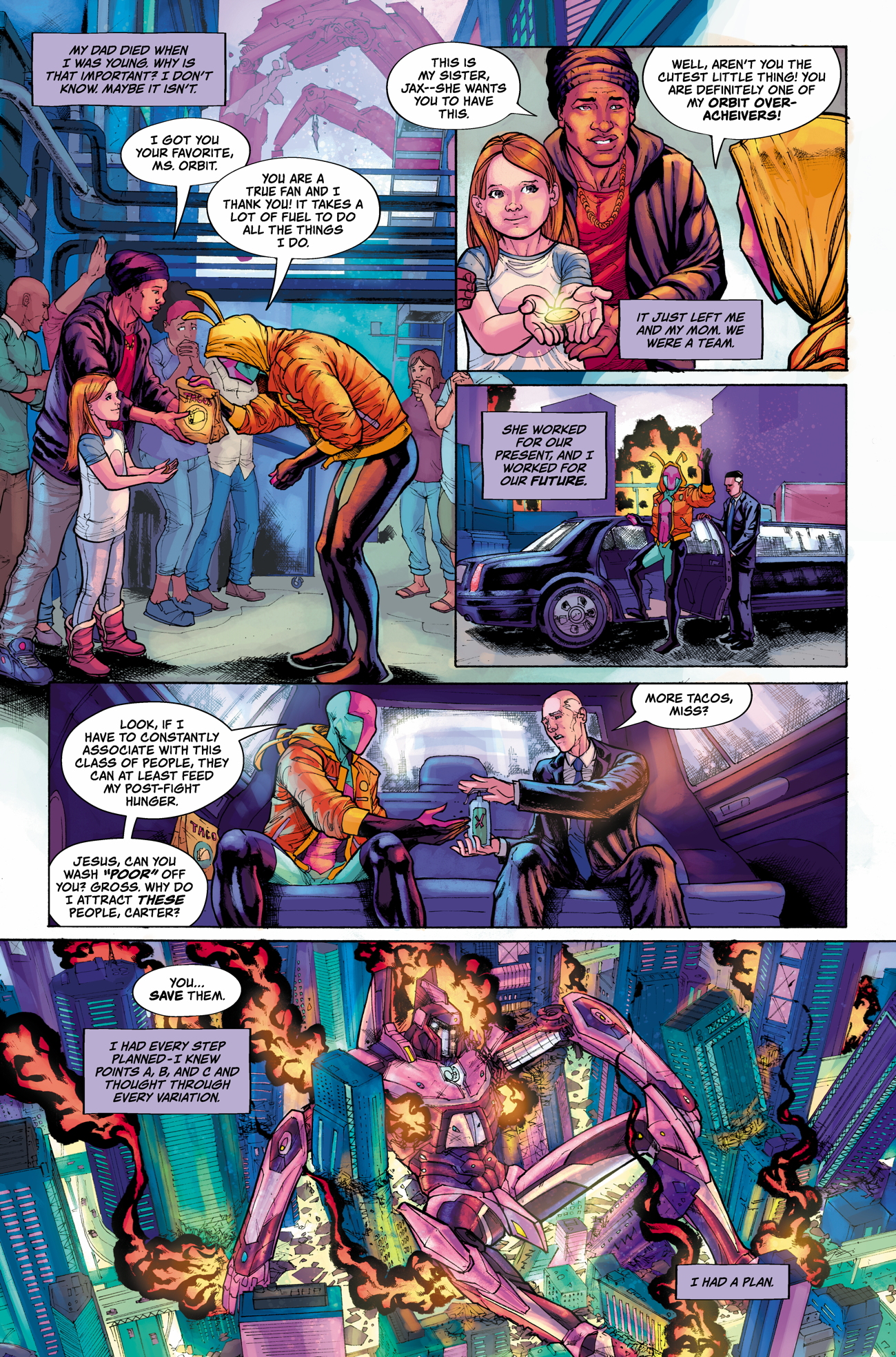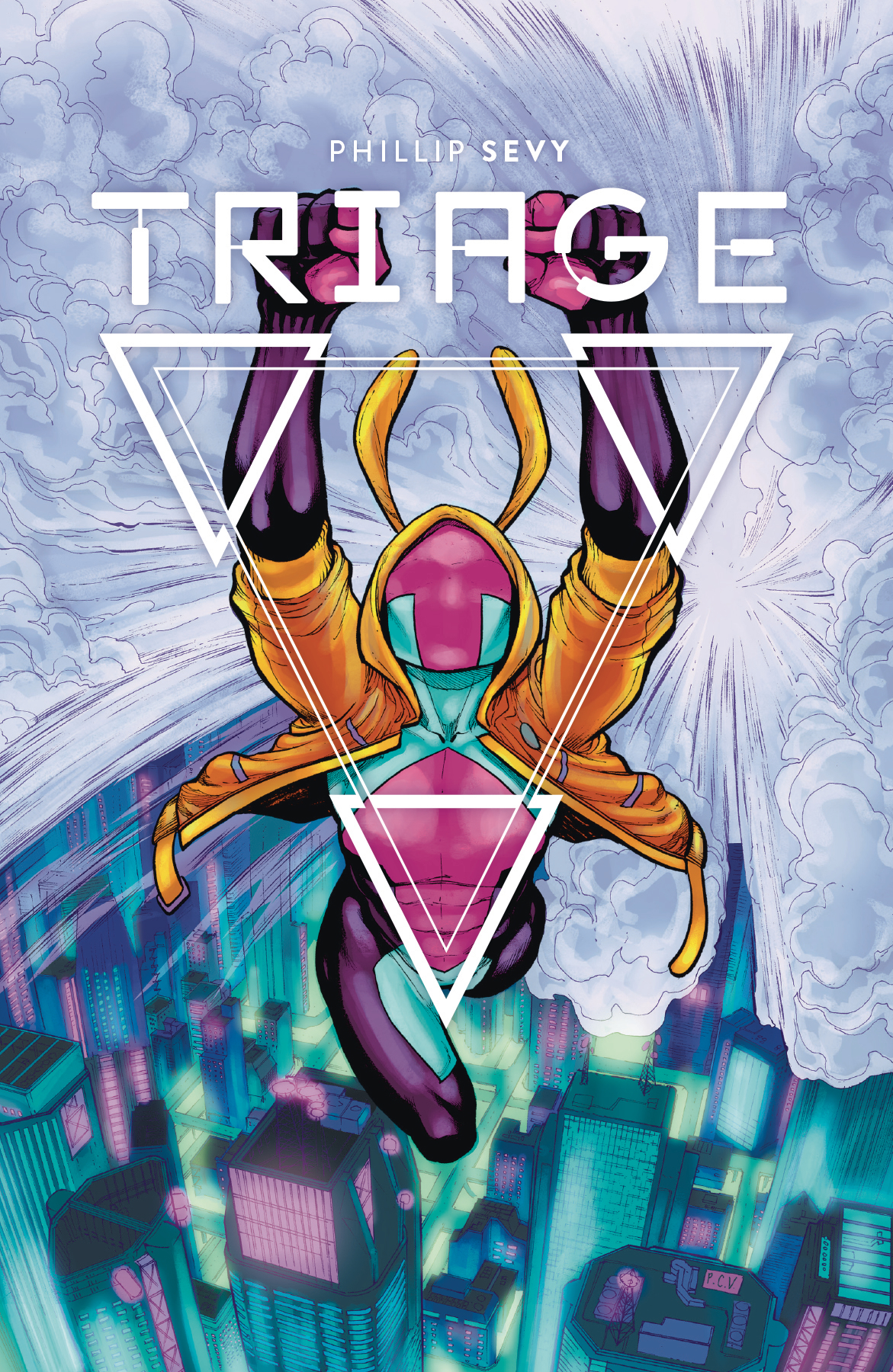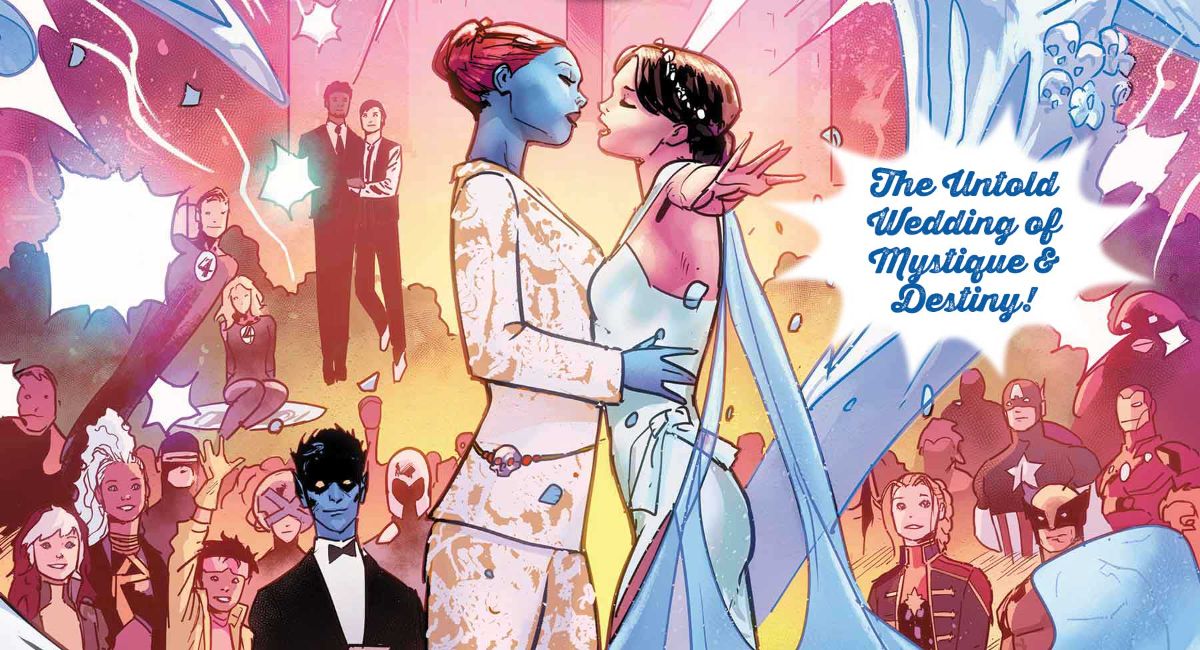In Triage, a new creator-owned comic by Phillip Sevy published through Dark Horse Comics, three vastly different women find themselves in a post-apocalyptic world where someone (or something) is hunting them down. Despite their differences, Evie, Marco, and Orbit must work together to figure out why they were assembled, what’s after them, and how they will survive this unfamiliar world.
Sevy is writing, illustrating, and coloring the five-issue mini-series, which debuted in September. At Rose City Comic Con 2019, The Beat sat down with him to talk about Triage, his creative process, and which current creators he admires, as well as how different it is to do nearly every part of a comic alone versus working with a team of collaborators.
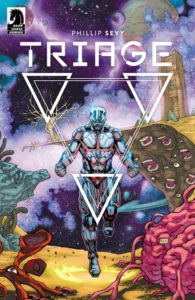
Samantha Puc: What was the inspiration behind Triage? What made you want to pursue this particular narrative?
Phillip Sevy: It’s a combination of two things. I was getting ready to pitch some things at San Diego Comic-Con last year and I had a couple pitches, and I was like, “Eh, I think [I need] one more — you never know.” And I was like, “Well, I want to draw a superhero story. I love sci-fi and I love post-apocalyptic dystopians,” so I was like, “Why don’t I come up with a way to mash all those genres together in the biggest possible way?”
From a narrative standpoint, Evie has gone through similar things that I’ve gone through. I spent the first couple years of my career working in corporate finance for investment banks and I was just absolutely miserable. I thought, “I need to get out of here, but I’ve done everything that I was supposed to do — how do I pivot and change everything and redefine my identity?” There was that aspect and then also, I grew up devoutly religious my whole life and in the last couple years, transitioned out of that. So there was that loss of identity, having again to redefine yourself as a 30-some-odd-year-old person: Will people still like me if I’m very different than who they thought I was initially? Putting those together is how Triage came to be.
Puc: Has the story changed since its initial conception?
Sevy: You know, not too much. I pitched it with just a paragraph of an idea and character designs. I didn’t have scripts or pages written out; it was very much just, “Here’s the concept. What do you think?” Once it got approved, then I was able to flesh out the concept and build what it was. Probably the only major difference is I’ve made more of a concerted effort to wrap up issue #5 so there are no question marks or to-be-continueds. I wanted to make it as complete a story as possible.
Puc: On that note, do you have other ideas for this universe? Do you have plans to continue at some point?
Sevy: I tried really hard to make it self-contained, but still also give you an idea that this is a very big universe and a very big playground. So if [Triage] is successful and if you want to read more, I’ve got ideas on what to do, but I also didn’t want to leave people just hanging. With comics, you’ve got four or five issues to give it your best shot and you never know if you’ll get more.
Puc: Has anything about this series surprised you?
Sevy: I’ve done some creator-owned stuff where I’m doing everything, but it’s more indie, self-published books that were done on my own time. Working on a larger platform for a bigger publisher, pretty much doing everything but letters — I was surprised how emotionally taxing it is. Working on collaborations over the years with either Tomb Raider or stuff with Top Cow, working with a team [gives] this inherent emotional load you all share. You’re like, “I’m going to do my best and I know my writer will do their best and the colorist will do their best,” so you kind of share that load. Doing it all myself, I realize, “Oh, if it doesn’t work, that’s all on me.” There’s a different level of added pressure. I enjoy it and it pushes me and inspires me, but I didn’t quite expect that level of responsibility I put on myself.
Puc: As far as lettering goes, was that your decision to work with a letterer, or was that Dark Horse?
Sevy: I’m working with Frank Cvetkovic, and Frank lettered The House, which is a horror graphic novel I did with Drew Zucker. He’s worked on some pitches with me and Frank is phenomenal; he gives me really great, really thought-out options. He brings a lot to the table as a pro, so he was the first letterer I reached out to as soon as I got approved.
Puc: So what is that process like, of doing the scripts, the illustrations, and the colors, and then having to send it off to a letterer? Is there a specific level of communication you have to have with him to make sure things look and feel the way you want them to, or…? Explain that to me.
Sevy: Sure! So once I have everything done, as far as art and writing goes, I’ll make sure I have a pass at my script because I want to make sure that when I send him a script to letter, it’s not a draft, like it’s as close to finished letters as possible. I really try to respect the time and effort he puts into stuff, so when I have changes, they’re not like, “Oh, I rewrote this whole page.” It’s more like, “Oh, can we tweak this there or tweak that there?”
Having worked together on stuff for quite a while, early on, we went back and forth quite a bit about different fonts, different word balloon styles, different everything until Frank, myself, and then Megan Walker, my editor, we found [the look]. 99 percent of the time, he nails it perfectly with the letters and the tweaks we have are usually just minor things to make everything look as best as possible.
Puc: You’ve talked about this a little bit, but I’m curious about working on this particular story, doing almost everything yourself for a larger publisher: Is there anything you’ve learned that you are going to take away from this book moving forward?
Sevy: That’s a really good question. Everything about it has kind of been a learning experience. It’s been really exciting in a real positive way. I really, really love working on my own stuff. I still want to collaborate with other people — there are so many amazing people in comics and I still want to do stuff. I’m not saying, from here on out I will only do my own books. I just want further opportunities to explore with that stuff. I’ve also learned that on my next creator-owned book, I want to be even further ahead of schedule before we announce it. We’re fine here, but that first issue took me four months to draw, just trying to get all the design and world-building and everything established and trying to define the visual look. That’s three times longer than I thought it was going to take.
Puc: There is a lot of world-building in that first issue. Obviously that’s something you have to do with a sci-fi type story, so how did you go about that?
Sevy: Megan and I worked together and got all the scripts written before I started the arc, for the most part. I’ve re-written them a whole bunch. But then it was a process of sketching constantly as I’m writing, to visualize what I’m writing; I built loads of Pinterest boards. A lot of my environments — once I figured them out from references and sketches — I would then go and build in 3D so I could see them fully realized, dimensionally. I did a solid month of design work before I started the first issue, which normally in comics you don’t have, or you’re not able to take that much time. Even with that, I only got about 75 percent of the first issue designed. Everything else, now that I have my building blocks, I’ll design as I go along. Getting everything initially started in that period helped save my life and helped refine how it was supposed to look.
Puc: Do you feel like your creative process has shifted as you’ve worked through each issue of Triage?
Sevy: I feel like with each issue, I’m just getting more comfortable with everything. Now I can do stuff a lot faster and I feel more comfortable in the world. That usually happens on any project I work on, but with this one, it felt so large and overwhelming at first but now I feel like we’ve got things figured out. By the time I was drawing and coloring issue #3, I was like, “Ah, now my lines are starting to do what I wanted them to do two issues ago!” Things like that.
Puc: What else are you working on currently?
Sevy: This is my only focus right now.
Puc: Do you have anything else in the works that you can talk about, or is it all secret?
Sevy: Nothing that I can quite talk about yet. We’ve got a couple ideas about what we want to do next; I’ve got a couple things here and there, circulating around, but as we got going, I realized, “Ooh, wow, I need to focus all of my energy on this book until we have it all done and safely sent off to the printer.” Then I can take a little bit of a break and attack whatever comes next.
Puc: You said a lot of the inspiration for this story was very personal — did you find that you had to make yourself more vulnerable in creating Triage than some of your other stories?
Sevy: I don’t know if it’s a direct byproduct of this book, but I think that’s one thing I’ve been working on in the last couple years. I’m a fairly closed-off person, so having to figure out how to be more vulnerable in general feels like a healthier way to be. A combination of that and working on this story has done that. I’ve always found myself to be more open and vulnerable in the things I write than in real life, but trying to do that in real life I think has helped me kind of access and tap into those things in the story. Hopefully people connect with it.
Puc: If you could choose any genre to create anything you wanted, would you go sci-fi, or horror, or something else?
Sevy: That’s a good question; I don’t even know! The fun thing about Triage is that it’s given me the chance to do a bunch of different genres. I’ve done some horror, self-published stuff before then. I’m not as genre-focused as I am story focused, and figuring out what is the best genre for the delivery of a story. Everything I write is overly personal at times, because that’s how I find energy to work on something day in and day out for a year or two or five or seven, depending on the project.
Puc: Since you do come at it from the perspective of, “What genre will this story best fit in?” — do you find that when you start working in new genres, that it’s a particular challenge?
Sevy: Not yet. Maybe at some point, I’ll come across something where I’m not familiar, but I’ve worked in genres I’m a very big fan of, so I understand the basic genre conventions, at least going in. Then figuring out how to best work inside that is always the challenge, like, what has been done before that’s familiar, so it allows people an access point, but how can we do it in such a way that’s hopefully unexpected?
Puc: Are there any creators whose work you are really into right now that you want to shout out?
Sevy: I’ve been asked this once or twice on panels recently and I immediately go to Brian K. Vaughan; he’s my favorite writer in comics. Yes, everyone expects that, but he’s so good. But I’d also like to give a shout out to some newer creators, like Tini Howard is one of my close friends and a phenomenal writer; Leah Williams, Vita Ayala, Mat Groom — who, it just got announced he’s doing a DC book and his Self/Made series from Image was brilliant. Those are some of the oness that keep me going, both established people and then new people that make me excited about the different voices and ideas they’re bringing into comics.
Puc: Coming to slightly smaller cons like [RCCC], do you find that you get to interact more with up-and-coming voices in comics?
Sevy: I think so, yeah. I love shows, mainly for networking — “networking,” to me, is like hanging out with cool people. Smaller shows, it’s a little bit easier to access people and no one has 7,000 meetings or 800,000 people, so it’s easier to walk up and talk to people, which is what I really enjoy.
Triage #2 by Phillip Sevy and Frank Cvetkovic hits shelves Wednesday, Oct. 9 from Dark Horse Comics. To keep up with Sevy on social media, follow him on Twitter @phillipsevy or check out his website, www.phillipsevy.com.


